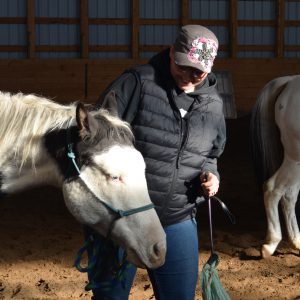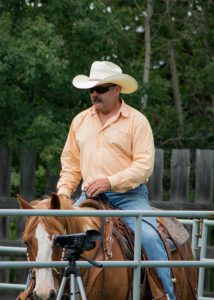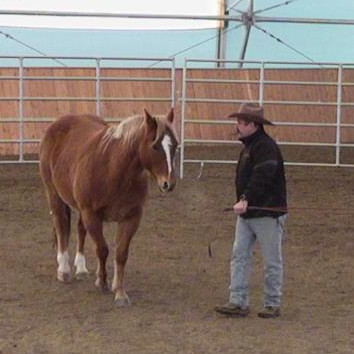Liberty work with horses is a fun way to engage with your horse. It’s also a great way to improve your riding.
“What??” you might ask, “liberty is groundwork, isn’t it?”
Liberty exercises are typically done in groundwork, true. In our style of horsemanship, there is only one significant difference between liberty groundwork and riding. And that difference is…you guessed it! In one case you’re in the saddle and in the other, you’re not.
To explain this, we’ll need to define what liberty is, in the context of our training style. The dictionary definition of liberty is
- The quality or state of being free:
- the power to do as one pleases;
- freedom from physical restraint;
- freedom from arbitrary control;
- the power of choice.
Mirriam-Webster’s dictionary. Retrieved from: http:www.mirriam-webster.com/dictionary/liberty
The Power to do as one Pleases
That’s a tough one to digest. We can certainly do as we please, anytime and anywhere, but not without ramifications. We have laws, the intent of which is to confine our actions to those accepted by our society, country, county, city, etc. Similarly, if a horse could do as it pleased, most likely he or she will be grazing or sleeping. But they also socialize. My wildie, Zeus, will seek me out to engage with me. He desires something that our relationship offers him. That’s a relationship that I’ve worked at.
What can we take away from this? That liberty is, in part, a relationship with a horse where they choose to be with you.
Freedom from Physical Restraint

Ultimately, what we’re working toward in liberty exercises is that we can direct our horse without a halter, headstall or round pen. This doesn’t mean, however, that we are prevented from using those tools. A halter isn’t physically restraining unless the lead rope is pulled on. Reins are not restraining unless there is a continuous tension. A round pen, or arena isn’t restraining unless the horse is being chased or trying to get out.
There are many tools we can use to build a liberty relationship with our horse as we work our way up to not needing tools at all.
Freedom from Arbitrary Control
Arbitrary in this context means, “ruling by absolute authority”. When working with a horse, what this means is that we are not controlling them. Consider this in the human context. A dictatorship is based on submission and control. What this means is that unless you do what you’re told, there is going to be a negative repercussion. Think of being a manager of a business. You can either force your employees to do their job (threaten them with unpaid days off or being fired) OR you can motivate them to want to do the best they can. Similarly, a horse never needs to be controlled nor forced to submit. What they need is to trust you enough to follow you, accept you as higher in the herd and have a belief that your leadership is a great choice because it meets their needs, answers their questions and relieves them from anxiety. When a horse follows you to that extent, there is no longer a need for control. Someone wise once said, “Control is an illusion.” I couldn’t agree more!
The Power of Choice
This is where liberty exercises can be fun. In our clinics we set up some exercises where your horse can make choices. Do they choose you? Do they choose to exercise their freedom and run, buck and roll? Do they choose another horse or person? In these exercises there is a great deal of laughter. And some pretty emotional moments too. There are not many things that touch our hearts more than having a horse choose to be with us over everything else.
Scott’s Definition of Liberty
What Liberty Isn’t
There are many different styles of liberty. In keeping with the definition above, we can think of some things that liberty is not. Then we’ll sort out what it actually is.
- only a movement or sequence that the horse performs on command;
- motivation by treats
- submission and control (do it or else)
- based only on cues from tools or sounds
- something that only happens when the horse is confined
There are many things we can train a horse to do, including some incredible tricks. These are amazing to watch and can be a lot of fun for you and your horse. They’re a little different than liberty though, because the horse is performing a trained response. Liberty in this context is something the horse is adept at from birth – and therefore something we need to learn.
The others are fairly obvious. If your horse is doing something for a treat, then they’re not following you, they’re performing for a treat. Forcing a horse to do something so that they learn they’ll be punished if they don’t clearly opposes the definition of liberty. If a movement is only based on a cue or treat, then the horse is following the cue or treat, but not necessarily you. If we open up the round pen gate and our horse chooses to leave instead of stay with you, then they’re only at liberty when the gate is open.

What Liberty Is
Liberty in the context of horses can mean a dozen different things. It’s no different than the word horsemanship – which really only means “a person working with a horse”. Different trainers will teach different techniques of liberty.
Body language is one of those phrases that is typically used in liberty discussions usually to explain how horses communicate, but it isn’t in my list of horse communication methods. Body language is the visible manifestation of what the horse is feeling. Body language is a set of expressions – no different than you scrunching up your face when you smell rotten milk. But because motions are obvious to see, we can get fooled into thinking that is the only way horses communicate…and further fooled into thinking that we can only communicate with horses that way.
In truth, horses communicate primarily through space and the energy they put into it. They also communicate through empathy: the ability to feel what another horse – or human – is feeling. Another important communication method is focus.
In my style of horsemanship then, liberty really is about humans being able to communicate with clarity. And thus…
Scott’s Definition of Liberty
An invitation to, and acceptance from, our horse to follow or mirror our focus, energy and intent.

Given this definition, the onus is on us to learn the intimacies of communicating with our horse in the way they instinctively understand, instead of trying to teach them to learn human. The other no less important piece to liberty is leadership. You might be able to communicate clearly with a horse, however if they’re of the mindset that you’re below them in the herd, then they rightfully have the choice whether to follow you or not. To add to this, a horse might see you as above them in the herd, but only trust you to a limited extent.
To sum it up then, establishing leadership, learning to communicate with a horse and building trust are the three required pillars for liberty.
How does this translate to Liberty?
Let’s look at this in the context of the athletic abilities of the horse. A horse can move in three different dimensions: left-right, forward-back and up-down. A horse does this by both:
- Moving their legs to relocate their body, or a part of it, like hind end or front end;
- Shifting mass in their bodies to affect their balance.
How fast, how much and in what direction these movements occur is based on the focus, energy and intent of the horse. Do you see how this is all coming together?
Though our ability to communicate like a horse, we can change their focus, shift their balance and have them follow our energy and presentation. Thus, we can ask a horse to do anything that they can already do with their body, without having to touch them.
What does this have to do with riding?
I’d like you to scroll up and reread the paragraph “Scott’s Definition of Liberty”. As you read through it, I’d like you to substitute the word riding wherever you see the word liberty.

Now consider for a moment how far reaching this can be. Liberty is not restricted to groundwork. In a sense, our style of horsemanship is about riding – at liberty. With a trusting belief in your leadership coupled with your ability to communicate, your horse can intimately follow your focus, energy and balance without aids such as reins, pushing with legs, kicking or exaggerated movements of your body in the saddle.
It’s not hard to believe. Horses follow each other in an intimate flow of energy and balance without using reins or lead ropes. Watch a herd of horses running together. We can certainly be a part of that connection. It takes a little learning and practice but it has exponential payoffs: your horse can move in balance and without brace. Your horse understands exactly what you want. Fights and pulling on reins are a thing of the past. The list goes on.
Interested in exploring liberty with your horse? Join Scott in a Liberty to Riding Clinic this summer!
Check out the Clinic Schedule
Transitioning to the Saddle
Groundwork is conducted with you in a position relevant to the horse’s eye. I’ll generally start with exercises in the front half of the horse’s vision – that is, they can see you when they look forward. The reason, which is particularly important for nervous or flighty horses, is that they’ll tend to be looking in a direction they’ll escape in, if the pressure becomes too much. So standing in a position that makes it easy for them to look at you just makes sense. We desire that our horses think of us when anxious instead of the instinctive thought of escape.
A disconnect between groundwork and riding can happen for a couple of reasons, and in this context it has to do with our position. We move from a spot where the horse can easily see us and move around us, to their back: a position they can’t see without turning their head. Thus, it is very important that we spend some time in the groundwork behind the horse’s eye.
Eventually, we’ll advance to a spot where we can drape our arm over the horse’s back and have them follow our energy and focus forwards and backwards, left and right, and laterally. Without a halter or any other restraining device. Then we have a high degree of certainty that they can do the same when we’re on their back.
You can watch examples of this in our Liberty Webinar series. When our horse is able to do this, they’re demonstrating a high degree of followership. They’re showing us that they can follow us very precisely when we’re behind their eye without the use of the reins, seat or legs.
The Basics of Liberty Webinar is taking place January 2020. Episodes are recorded and will be available on our website. Learn more about webinars and 1-on-1 online training sessions.
This is a great exercise when starting a colt or working through the struggles of a fear-based horse. It is one piece of teaching a horse what it is like to be ridden. Another important piece is having a horse follow our energy up and down through gait changes. But this isn’t possible when we’re adjacent to the saddle area with our arm over their back…unless you can run much faster than I can!
This is where liberty at increasing distances can help. It’s also where we can build a connectedness that we can take into our riding.
Liberty to Build a Connection
Here’s a question for you. At what distance from you does your horse consider himself or herself to be free? Of course, in liberty work a horse is technically free. Perhaps a better way to put it is: at what distance does your influence end? At this point your horse won’t feel they have to follow you any longer.

This distance is different for every horse out there. For horses that are fiercely independent, your area of influence might be very small. Those horses are not overtly seeking leadership and likely won’t just instinctively follow you. We can help out those situations by developing our trusted leadership and finding scenarios where our horse might struggle – and showing them that following us saves the day. Confident horses that have independent thinking can present difficulties in the saddle – you might feel you have to keep a tight rein or be steering them constantly. To solve that problem, we can use liberty work to build our area of influence – increasing the distance at which our horse will still stick with us.
On the flip side are those horses that are terrified. Many times those horses are the easiest to do liberty work with, because they’re seeking leadership. They need to be following another horse. Or you. In these situations, we can use liberty work to give them confidence. We need to be careful to move slowly and not cause excess pressure that would cause them to flee. As their ability to follow us increases, we can then introduce pressures to observe that they stay with us.
Liberty exercises are fantastic in order to build a trusted leadership connection: a relationship that reaps benefits when you’re in the saddle. What true liberty work really does is cause you to become proficient in speaking the language of the horse and put it to practical every-day purpose.
Scott Phillips
January 2020
